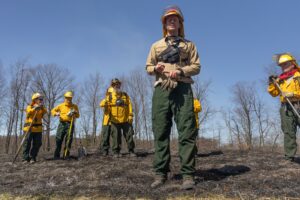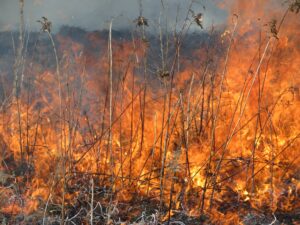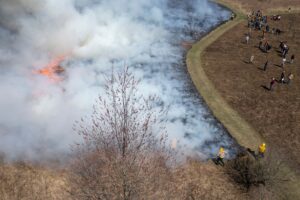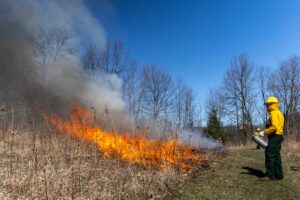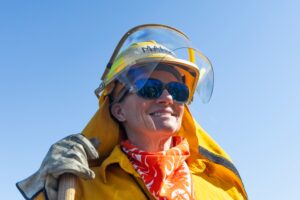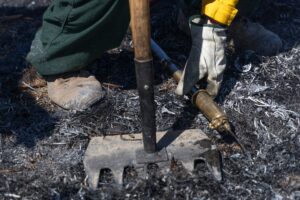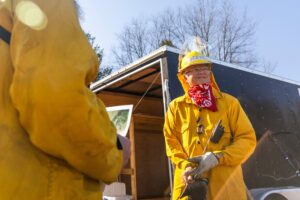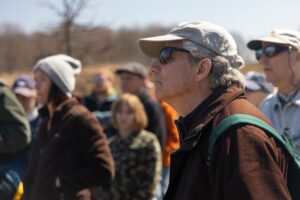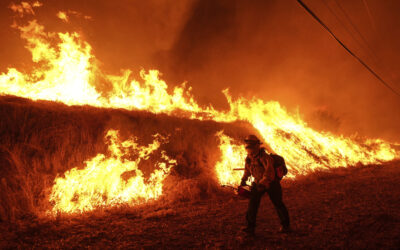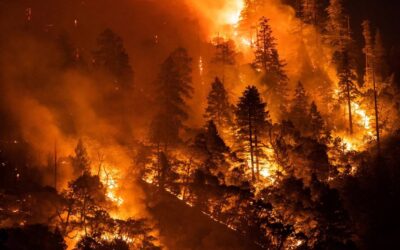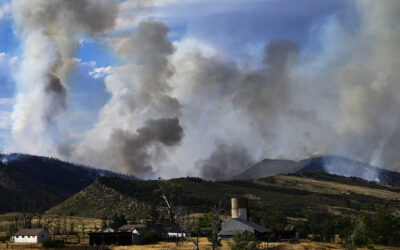Michigan’s forests face increasing wildfire risks as climate change worsens conditions everywhere. MLive recently examined that threat and a somewhat paradoxical environmental solution: experts say more controlled burns are needed to prevent devastating wildfires.
Related: Fighting wildfire with fire: Can Michigan burn its way to healthier forests?
Related: More ‘good fire’ in Michigan restores Indigenous land practices
Here are five takeaways from the reporting project:
1. Michigan faces significant wildfire risks despite its lush forests
Experts warn that decades of fire suppression left northern Michigan forests dangerously primed for catastrophic blazes under certain weather conditions. Fire expert Michele Richards describes Michigan’s pine forests as “a tinder box waiting to go” because of the lack of prescribed fires in these areas. The highest risk area is Crawford County, deep within the state’s flammable jack pine forests.
Recent history shows the threat is real. The Four Mile Road Fire in 2008 cost $1 million in firefighting expenses and threatened Grayling, while the 2010 Meridian Boundary Fire destroyed 12 homes near Roscommon. In 2012, the Duck Lake Fire in the Upper Peninsula destroyed more than 20 homes and threatened Newberry. Climate change is expected to worsen wildfire risks with hotter, drier periods.
2. Michigan significantly lags behind neighboring states in prescribed burning
Despite having approximately 20 million acres of forest and wildland, Michigan treats only about 20,000 acres annually with prescribed fires – a fraction of what experts say is needed. This places Michigan far behind neighboring Great Lakes states in prescribed fire management practices. Wisconsin burns between 50,000 and 75,000 acres yearly, while Minnesota treated over 83,000 acres with controlled burns last year.
Steven Woods, an ecologist and wildland fire specialist for the Michigan Department of Natural Resources’ parks and recreation division, underscored the conundrum: “We propose about a third of the number of burns that we would like to do, and we burn about a third of the units that we propose. So, we are not getting enough fire done.” This backlog of needed burns is creating what western states call a “fire deficit.”
3. Multiple barriers prevent more widespread prescribed burning
Several obstacles limit Michigan’s prescribed burning efforts. Limited certified personnel, equipment shortages, and narrow windows of appropriate weather conditions all constrain controlled burning operations. Bureaucratic challenges further complicate matters – state and federal agencies typically don’t collaborate on burns due to funding rules, liability protections must be settled, and burn plans face approval hurdles.
Additionally, prescribed fires consistently take a backseat to fighting active wildfires. Brian Stearns, a prescribed fire specialist for the U.S. Forest Service in the Huron-Manistee National Forests, said that even in ideal situations, “We’re trying to burn in the morning… and fight fire in the afternoon.” This spring, most state DNR controlled burns were paused as workers focused on cleanup after a devastating ice storm wrecked northern forests.
4. New initiatives aim to expand Michigan’s prescribed burning capacity
Efforts are underway to increase Michigan’s prescribed burning capabilities. The DNR established a state certification program for private sector prescribed burn managers, with the first class of 20 managers scheduled for September. GraceAnna Cooper, DNR prescribed fire specialist, expects this program to significantly increase burning capacity statewide.
Financial support is also growing. In 2023, Gov. Gretchen Whitmer proposed and lawmakers approved a $3.7 million increase to the DNR budget for wildfire suppression and prescribed fire. This recurring annual funding allowed the agency to upgrade equipment and hire 13 full-time wildlife fire specialists. Additionally, a unique partnership between the Sault Ste. Marie Tribe of Chippewa and the Hiawatha National Forest in the Upper Peninsula demonstrates how collaboration can increase burning capacity, with thousands of acres scheduled for controlled burns this season.
5. Prescribed burning represents a return to Indigenous land management practices
Michigan’s Native peoples used controlled burning for millennia before European colonization introduced fire suppression policies. Indigenous communities burned habitats for various purposes, including blueberry production, insect control, pine regeneration, and improved hunting grounds. Tribal elder Frank Ettawageshik of the Little Traverse Bay Bands of Odawa in Harbor Springs said more controlled burning would bring back a key cultural element of the traditional ecological knowledge of Michigan’s Native peoples: “It’s restoring natural land practices, taking care of the land in a way that our ancestors had this knowledge.”
Today, researchers are studying tree rings to understand historical fire patterns, revealing that Native burning was widespread in Michigan. Dani Fegan, the Sault Tribe’s forestry manager, explained that logging-era emphasis on timber harvesting and tree replanting moved away from Indigenous practices that evolved with the landscape over thousands of years. The return to prescribed burning represents what some tribal experts call “good fire” – an integral part of Indigenous land stewardship.
- Land Conservancy of West Michigan Conservation Director Justin Heslinga addresses the crowd on Saturday, April 12, 2025 during a Learn & Burn at Saul Lake Bog Nature Preserve in Rockford, Mich. Hosted by Land Conservancy of West Michigan and the Michigan Prescribed Fire Council, the event offered members of the public a chance to witness a live 1-acre prescribed burn demonstration to learn about the ecological benefits from such techniques in tall grass prairies.
- Volunteer Courtney Cheers stands by before the burn on Saturday, April 12, 2025 during a Learn & Burn at Saul Lake Bog Nature Preserve in Rockford, Mich. Hosted by Land Conservancy of West Michigan and the Michigan Prescribed Fire Council, the event offered members of the public a chance to witness a live 1-acre prescribed burn demonstration to learn about the ecological benefits from such techniques in tall grass prairies.
- Volunteer Courtney Cheers checks for hotspots around the perimeter near a small slop-over on Saturday, April 12, 2025 during a Learn & Burn at Saul Lake Bog Nature Preserve in Rockford, Mich. Hosted by Land Conservancy of West Michigan and the Michigan Prescribed Fire Council, the event offered members of the public a chance to witness a live 1-acre prescribed burn demonstration to learn about the ecological benefits from such techniques in tall grass prairies.
- Grasses burn in a prescribed fire at Mitchell Creek Meadows nature preserve near Traverse City, Michigan, on Sunday, March 3, 2024, as part of wildland fire training. (Sheri McWhirter | MLive.com)
- An aerial view during a Learn & Burn at Saul Lake Bog Nature Preserve on Saturday, April 12, 2025 in Rockford, Mich. Hosted by Land Conservancy of West Michigan and the Michigan Prescribed Fire Council, the event offered members of the public a chance to witness a live 1-acre prescribed burn demonstration to learn about the ecological benefits from such techniques in tall grass prairies.
- Volunteer Andrew Lidral uses a drip torch to start the burn on Saturday, April 12, 2025 during a Learn & Burn at Saul Lake Bog Nature Preserve in Rockford, Mich. Hosted by Land Conservancy of West Michigan and the Michigan Prescribed Fire Council, the event offered members of the public a chance to witness a live 1-acre prescribed burn demonstration to learn about the ecological benefits from such techniques in tall grass prairies.
- Volunteer Mary Hefferan chats with fellow crewmates after suiting up on Saturday, April 12, 2025 during a Learn & Burn at Saul Lake Bog Nature Preserve in Rockford, Mich. Hosted by Land Conservancy of West Michigan and the Michigan Prescribed Fire Council, the event offered members of the public a chance to witness a live 1-acre prescribed burn demonstration to learn about the ecological benefits from such techniques in tall grass prairies.
- A volunteer picks up the nozzle of a hand-pump water pack on Saturday, April 12, 2025 during a Learn & Burn at Saul Lake Bog Nature Preserve in Rockford, Mich. Hosted by Land Conservancy of West Michigan and the Michigan Prescribed Fire Council, the event offered members of the public a chance to witness a live 1-acre prescribed burn demonstration to learn about the ecological benefits from such techniques in tall grass prairies.
- Steve Van Dyke chats with fellow volunteers while suiting up on Saturday, April 12, 2025 during a Learn & Burn at Saul Lake Bog Nature Preserve in Rockford, Mich. Hosted by Land Conservancy of West Michigan and the Michigan Prescribed Fire Council, the event offered members of the public a chance to witness a live 1-acre prescribed burn demonstration to learn about the ecological benefits from such techniques in tall grass prairies.
- Guests listen to a debriefing on Saturday, April 12, 2025 during a Learn & Burn at Saul Lake Bog Nature Preserve in Rockford, Mich. Hosted by Land Conservancy of West Michigan and the Michigan Prescribed Fire Council, the event offered members of the public a chance to witness a live 1-acre prescribed burn demonstration to learn about the ecological benefits from such techniques in tall grass prairies.
Sign up to receive Lake Effect, MLive’s weekly climate and environment newsletter.
Related articles:
Possible EPA rule change could rekindle more prescribed fire in Michigan forestry
Can intentional forest burning across the Great Lakes help prevent runaway wildfires?
The roster of ‘future old-growth’ forests in Michigan is expanding
Hundreds march to ‘shatter the silence’ of missing, murdered Indigenous people
Bills on Indigenous regalia, wild rice among Michigan’s tribal victories in 2024
©2025 Advance Local Media LLC. Visit mlive.com. Distributed by Tribune Content Agency, LLC.

